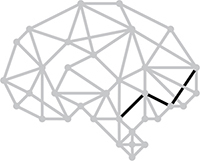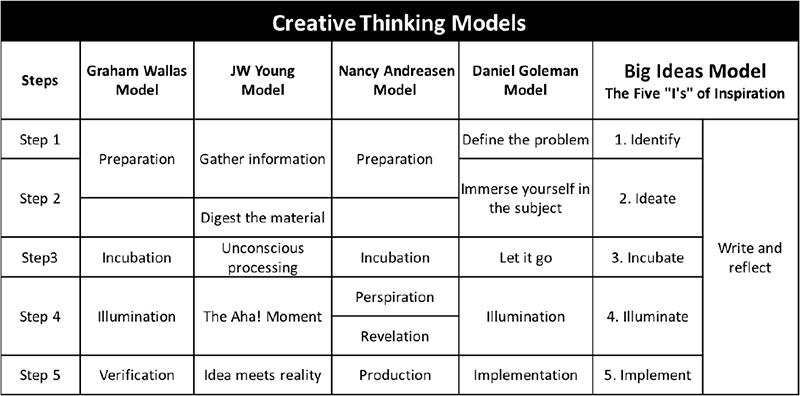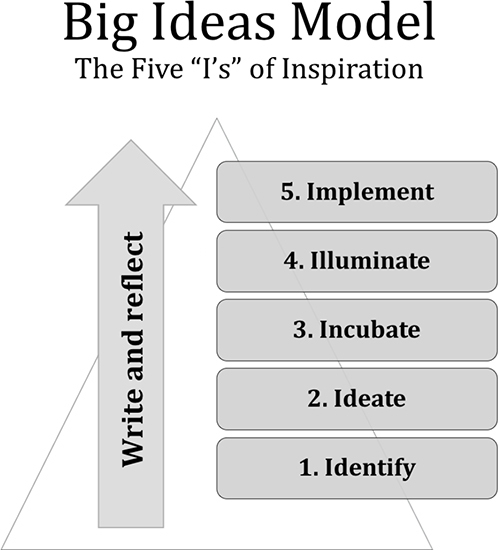CHAPTER 9
CREATIVE THINKING MODELS
“To live is to have problems, and to solve problems creatively is to grow.”
—J.P. Gilford
S
PEAKING TO HARVARD STUDENTS, FACEBOOK
founder and
CEO
Mark Zuckerberg warned that the “idea of a single Eureka moment” in which a lone thinker has a groundbreaking epiphany is a myth. Zuckerberg characterized the idea of an Aha! Moment or a flash of insight as “a dangerous lie” that discourages real creativity.
74
Zuckerberg might not believe it, but countless world-changing epiphanies
have
arrived in a single Eureka moment to some of the most brilliant women and men on the planet.
OUTSIDE IN
The ancient Greeks thought that inspired ideas were given to men and women by spirits or demons—both good and malevolent mystical beings called Muses. These ethereal, spiritual forces were believed to influence behavior and bestow thoughts and creative ideas on humans. The Muse visited, often at night, and transmitted ideas. Human minds were the vessels that captured and used those ideas.
Many people, especially creatives, still believe in the mystical Muse—an unexplainable source of inspiration that seems to float in the air—hard to harness and impossible to control.
Pulitzer Prize finalist poet Ruth Stone (1915–2011) said sometimes she could feel and hear a poem coming at her from “over the landscape.” It was like a “thunderous train of air that came barreling down.” When she felt it coming, “it shook the earth under her feet.” Musician Tom Waits hears melodies coming from an external “genius.” Johann Wolfgang von Goethe (1749–1832) claimed to have written his novella
The Sorrows of Young Werther
with hardly any conscious input, as if he was holding a pen that moved on its own.
Many world-changing discoveries have come from a single flash of insight. Einstein’s theories on light, time, and gravity came in an instant, following years of mental effort. Geneticist Barbara McClintock, author J.K. Rowling, and Johannes Gutenberg all had similar experiences.
There are countless examples of people who were stuck, sometimes for years, with a problem they couldn’t solve and then unexpectedly, the answer arrived fully formed. That is what happened to Archimedes when he stepped into his bath.
These sudden insights tend to come when the person has followed a centuries-old process for coming up with Big Ideas. The Aha! Moment is not a magical event for the unprepared.
CREATIVE THINKING MODELS
It is possible to gain greater access to inspiration and generate more Aha! Moments in your life. In the last hundred years, there have been a number of theories on the creative process and how to tap into the power of the brain.
THE WALLAS MODEL
In 1926, English social psychologist Graham Wallas (1858-1932) proposed one of the first models for creativity and inspired ideas. His model has four stages:
|
1.
|
Preparation—Know your field of study and be well prepared. |
|
2.
|
Incubation—Spend time away from the problem. |
|
3.
|
Illumination—Receive the “click” or “flash” of a new idea. |
|
4.
|
Verification—Determine if the “happy idea” actually solves the problem. |
THE YOUNG MODEL
In 1969, advertising executive James Webb Young (1886–1973) offered a five-step method for generating ideas.
75
It is similar to Wallas’s model but includes the stage that Young calls, “working it over in your mind.”
|
1.
|
The gathering of raw materials—both materials of your immediate problem and materials from a constant enrichment of your store of general knowledge |
|
2.
|
The working over of these materials in your mind |
|
3.
|
The incubating stage—where you let something besides the conscious mind do the work of synthesis |
|
4.
|
The actual birth of the idea, the “Eureka! I have it!” stage |
|
5.
|
The final shaping and development of the idea to practical usefulness |
THE ANDREASEN MODEL
Nancy C. Andreasen, psychiatrist and neuroscientist at the University of Iowa and author of The Creative Brain: The Science of Genius,
defines creativity as “the ability to bring together disparate ideas in new and useful combinations.” Andreasen has developed her own model for developing creative ideas.
|
1.
|
Preparation—an analytical time when the basic information or skills are assembled |
|
2.
|
Incubation—a more intuitive and unconscious time in which you connect the dots in a default state |
|
3.
|
Perspiration—hard work and extensive thinking about the problem |
|
4.
|
Revelation—the Eureka experience when you literally feel the tumblers of your mind click into place and you say, “A-ha, I have found the solution!” |
|
5.
|
Production—a time when insights are put into a useful form and shared with others |
THE GOLEMAN MODEL
Psychologist Daniel Goleman offers a slight variation on these models.
|
2.
|
Immerse yourself in the problem. |
|
3.
|
Let it all go and let the gamma spike come to you. |
|
4.
|
Implement the solution you received during the gamma spike.
76
|
All of these models lay out similar steps to illumination, and people everywhere use variations of the models without realizing it. If you know and understand the model, you can deliberately use it to think more creatively, find better solutions to life’s problems, and have more Aha! Moments.
THE BIG IDEAS MODEL
The Big Ideas Model incorporates many of the elements proposed by earlier thinkers. The model aligns with what we know about how the mind functions, and people have been using versions of it for thousands of years. It is a summation of best practices for creative thinking. And it works!
We’ve assigned numbers to the steps in the Big Ideas Model, but it’s important to understand that the steps do not necessarily follow each other in a rigid consecutive order. At any one time, you could be working on an aspect of each of the five steps, and they often overlap each other as you learn and practice the principles of our model.
THE FIVE I’S OF INSPIRATION
|
|
First—Identify:
Clearly define what you want to understand or discover.
|
|
|
Second—Ideate:
Develop your idea and gather information.
|
|
|
Third—Incubate:
Stop thinking about the problem and give your brain a chance to rest and renew.
|
|
|
Fourth—Illuminate:
Wait for insights to come and write them down when they arrive.
|
|
|
Fifth—Implement:
Put your best ideas into action.
|
EINSTEIN AND THE BIG IDEAS MODEL
This model worked for Albert Einstein on more than one occasion. Theoretical physicist Michio Kaku, tells of Einstein’s struggle and the eventual Aha! Moment that changed physics forever.
One day around May of 1905, Einstein went to visit his good friend Michele Besso, who also worked at the patent office, and laid out the dimensions of the problem that had puzzled him for a decade. Using Besso as his favorite sounding board for ideas, Einstein presented the issue: Newtonian mechanics and Maxwell’s equations, the two pillars of physics, were incompatible. One or the other was wrong. Whichever theory proved to be correct, the final resolution would require a vast reorganization of all of physics. He went over and over the paradox of racing a light beam. Einstein would later recall, “The germ of the special relativity theory was already present in the paradox.” They talked for hours, discussing every aspect of the problem, including Newton’s concept of absolute space and time, which seemed to violate Maxwell’s constancy of the speed of light. Eventually, totally exhausted, Einstein announced that he was defeated and would give up the entire quest. It was no use; he had failed.
When he returned home that night…he remembered riding in a street car in Bern and looking back at the famous clock tower that dominated the city. He then imagined what would happen if his street car raced away from the clock tower at the speed of light. He quickly realized that the clock would appear stopped, since light could not catch up to the street car, but his own clock in the streetcar would beat normally.
Then it suddenly hit him, the key to the entire problem. Einstein recalled, “A storm broke loose in my mind.” The answer was simple and elegant: time can beat at different rates throughout the universe, depending on how fast you moved.... This meant that events that were simultaneous in one frame were not necessarily simultaneous in another frame, as Newton thought. He had finally tapped into “God’s thoughts,” he would recall excitedly. “The solution came to me suddenly with the thought that our concepts and laws of space and time can only claim validity insofar as they stand in a clear relation to our experiences…. By a revision of the concept of simultaneity into a more malleable form, I thus arrived at the theory of relativity.”
The day after this revelation, Einstein went back to Besso’s home, and without even saying hello, he blurted out, “Thank you. I’ve completely solved the problem.” He would proudly recall, “An analysis of the concept of time was my solution. Time cannot be absolutely defined, and there is an inseparable relation between time and signal velocity.”
For the next six weeks, he furiously worked out every mathematical detail of his brilliant insight, leading to a paper that is arguably one of the most important scientific papers of all time. According to his son, he then went straight to bed for two weeks after giving the paper to Mileva [his wife] to check for any mathematical errors. The final paper, “On the Electrodynamics of Moving Bodies,” was scribbled on thirty-one handwritten pages, but it changed world history.
77
Can you identify the five stages of the inspired thinking process in Einstein’s experience? After ten long years of deliberation, his brain finally connected the dots and delivered the foundational principles of special relativity to his consciousness in an instant. Einstein’s Aha! Moment changed the world.
The rest of this book will talk in detail about the five I’s of the Big Ideas Model and how you can put them into action.
Are you ready to be changed?








